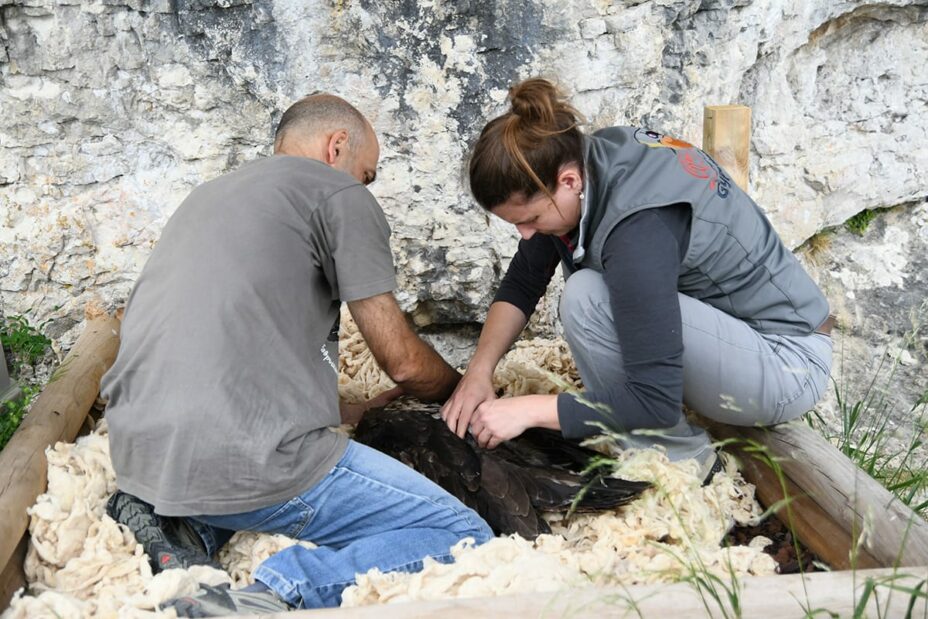
Three years since the LIFE GypConnect project began the sixth edition of the project’s bi-annual newsletter has just been released.
Highlights from the LIFE GypConnect project
Among the various news items published in the newsletter, our very own Alex Llopis outlines the Bearded Vulture Captive Breeding Network’s distribution strategy of birds across the network of zoos, breeding centres and private collections to ensure the optimum breeding results and make sure the birds are safe from disease such as West Nile Virus. The travels between the French pre-Alps and the Pyrenees of released bird Calendretto are highlighted to illustrate the success of the of the project in establishing a corridor between the two populations in the Alps and the Pyrenees.
Monitoring of breeding pairs in Aude
Back in October the project team began monitoring the two breeding pairs now established in Aude, French pre-Pyrenees. These are the easternmost breeding pairs in the whole of the Pyrenean chain, so important for the bridge towards the Causses. One couple, K1, which successfully raised young birds Roc Genèse and Flamadel, was observed at their usual nesting site. Also observed was a third bird joining the pair – last year the presence of a third bird was thought to have contributed to the pair’s breeding failure. Meanwhile the H7 couple, that began breeding in 2018, are using a nest formerly used by a Golden Eagle pair. This pair have been in the area for five years and it’s hoped that this year will be the year they breed successfully.
Understanding the threat of lead poisoning as part of LIFE GypConnect
Florence Roque and Jennifer Blondeau from the Centre National d’Informations Toxicologiques Vétérinaires shared their work on understanding lead poisoning. The CNITV carry out autopsies and toxicological analysis as part of the LIFE GypConnect project to help the team limit the threat to vultures in the region. There is a growing body of evidence that accumulating lead has a sub-lethal effect on vultures that increases the likelihood of them colliding with electricity infrastructure or exhibiting behaviour that can lead to injury and death. Whilst lead is in the environment through soil, surface and ground water, and in the air, the largest source of lead that leads to lead poisoning in scavenging birds is contamination of food sources through the use of lead ammunition by hunters. A 2018 study by the European Chemicals Agency suggests that around 14,000 tonnes of discarded lead shots are left across Europe. The acidity of the digestive tract of vultures allows the dissolution of the lead shot consumed from the remains of animals shot with lead ammunition, which in turn passes into the bloodstream. The CNITV have analysed the levels of lead in the livers of 54 individuals vultures and raptors as part of the project and have found that 49 of those had non-toxic levels of lead contamination (around 1.1 μg / g) including 38 Griffon Vultures, five Cinereous Vultures and three Bearded Vultures. A further five Griffon Vultures were found to have toxic levels of lead in their liver (over 20μg / g) which caused their deaths.
Making electricity infrastructure safe

Since 2016 the LIFE GypConnect team have been carrying out an inventory of the electrical lines and poles across the Grands Causses, and in December 2017 following the electrocution of Bearded Vulture Pronatura, the first phase of a work programme to make the infrastructure safe for vultures began, with a second phase completed in September 2018. Electricity firm ENEDIS in Aveyron and Lozère worked with the project team to make safe around 6km of lines between the Gard communes of Revens and Lanuejols, within the perimeter of the release site of captive-bred Bearded Vultures. Meanwhile in the Baronnies work has been completed making an inventory of the medium voltage power lines. Project partners Vultures in Baronnies worked on the same protocols of identifying the most dangerous power lines, in collaboration with electricity company ENEDIS Drôme-Ardèche. The next part of this project will carry out mitigation work on these lines to make sure they are safe for vultures and other birds such as making them more visible to reduce collision.
The sixth LIFE GypConnect letter is available to download below in French.
La Plume du LIFE Nr. 6 ![]() LIFE GypConnect newsletter no. 6 (French) LettreDInformationN6_Web.pdf Adobe Acrobat Document 3.1 MB Download
LIFE GypConnect newsletter no. 6 (French) LettreDInformationN6_Web.pdf Adobe Acrobat Document 3.1 MB Download
LIFE GypConnect
Led by the League pour la Protection des Oiseaux (LPO), in partnership with the Vautours en Baronnies, LIFE GypConnect aims to establish a breeding population of Bearded Vultures in the Massif Central and Department of the Drôme. Releasing captive-bred Bearded Vultures into the wild at sites such as the Parc Naturel Régional des Grands Causses and Parc Naturel Régional des Baronnies Provençales will create a core population that will connect the two populations of the species in the Alps and Pyrenees. To facilitate movements between the new population and the Alpine and Pyrenean populations the LIFE GypConnect team is creating a network of supplementary feeding stations, and tackling threats such as poisoning, and collision and electrocution with the electricity infrastructure.
In 2018 three birds were released in the Baronnies, building on the release of eight birds in 2017, four in the Grands Causses, two in the Baronnies and two in Vercors. The project is co-funded by the EU LIFE fund and by the MAVA Fondation.







